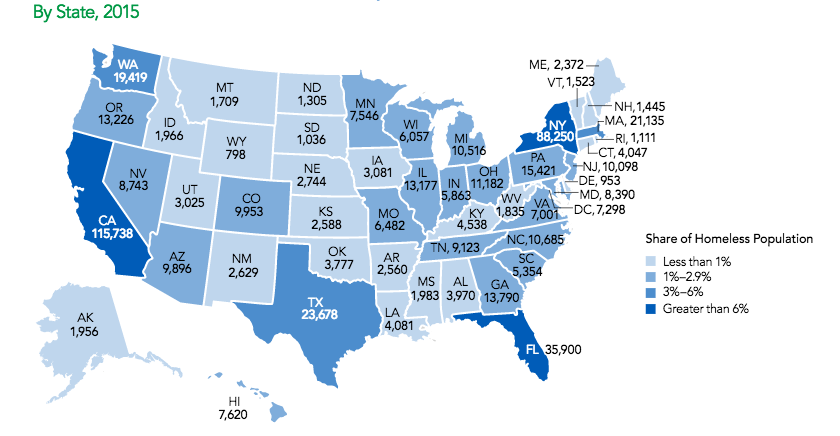The number of homeless people in the United States fell 2 percent from 2014, the Obama administration announced on Thursday.
On a single night in the last week of January, the government counted 564,708 homeless people who were either sheltered or unsheltered. That’s down slightly from the 578,424 people counted on a single night in January, 2014. Since 2007, the overall homeless count has decreased 11 percent, according to the Department of Housing and Urban Development.
Despite the overall decrease, the government is conceding that it will not reach its goal, set in 2010 by the Interagency Council on Homelessness, of ending veteran homelessness by the end of the year. As of January 2015, there were 47,725 homeless veterans, a 4 percent decrease since 2014. However, since 2010 there has been a 47 percent decrease in the number of homeless veterans.
In addition to the goal of ending veteran homelessness, the Obama administration also set a goal of ending homelessness for families, youth and children by 2020.
In January, more than 206,000 people in families with children experienced homelessness, a decrease of about 10,000 from 2014. Between 2010 and 2015, family homelessness declined by 15 percent, the HUD report revealed.
Steve Berg, vice president for programs and policy at the National Alliance to End Homelessness, said that although any decrease is welcome, the data says more than that.
“There are still way too many homelessness people and we have a lot of work to do,” Berg told the Washington Examiner. “This [report] is a reminder of that, even if the decrease in homeless people is in the right direction.”
Berg said his organization plans to delve deeper into the report and analyze numbers, such as where are the states where the homeless population went down and where it went up.
Other important numbers from the HUD report based on the data collected in January 2015:
- 23 percent of people experiencing homelessness are under 18; 9 percent are between the ages of 18 and 24; and 68 percent are over the age of 24.
- Most people experiencing homelessness are men. The sheltered population is 55 percent men, while the unsheltered population is 71 percent men.
- Transgender homeless persons made up 0.2 percent of the total homeless population, or nearly 1,300 people.
- Most homeless people were either white (49 percent) or black (40 percent).
- California accounted for 21 percent (roughly 116,000 people) of the nation’s homeless population on a single night. California had the highest percentage of homeless people counted in unsheltered locations (64 percent). California also had the second largest increase in homelessness between 2014 and 2015 (1,786 more people).
- New York had the largest increase in homelessness between 2014 and 2015 (7,660 more people).
- Homelessness declined in 33 states and the District of Columbia between 2014 and 2015, with the largest decreases coming in Florida (5,642 fewer people) and Texas (4,817 fewer people).
- However, between 2007 and 2015, homelessness increased in 18 states and D.C., while it decreased in 32 states.
- Among homeless people in families with children, one in four was in New York (26 percent, or 52,115 people), though less than one percent were unsheltered.
- Between 2014 and 2015, homelessness among families decreased in 34 states and D.C., though it did increase in 17 states.
- There were 180,760 homeless children and youth on a single night in January 2015, representing about one-third of all homeless people
- More than one in 10 homeless adults was a veteran.
- The number of homeless veterans declined in 33 states and increased in 17 states and D.C. between 2014 and 2015. The state with the biggest numerical decrease was California, while Arizona saw the largest increase (362 more veterans).

Graph courtesy of HUD

